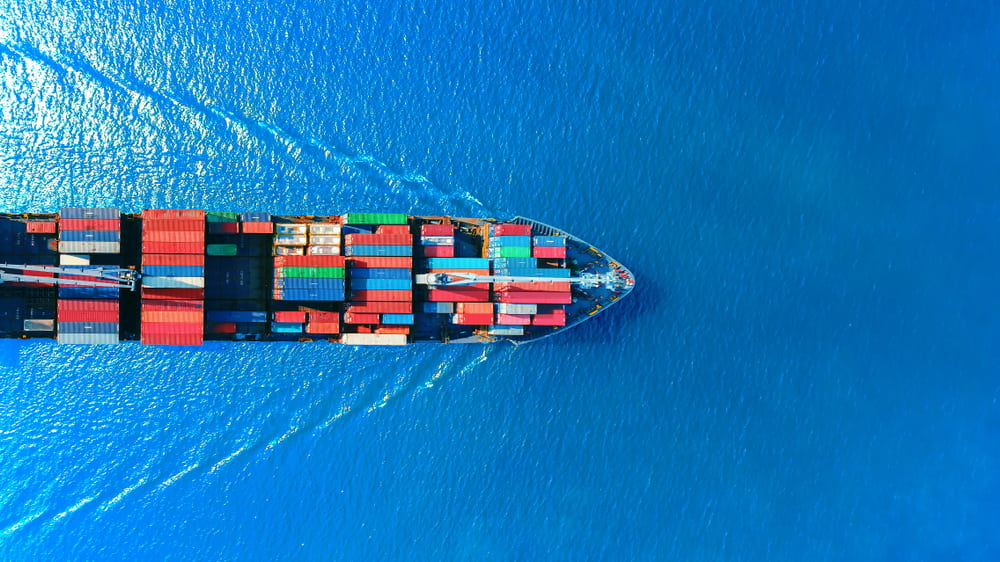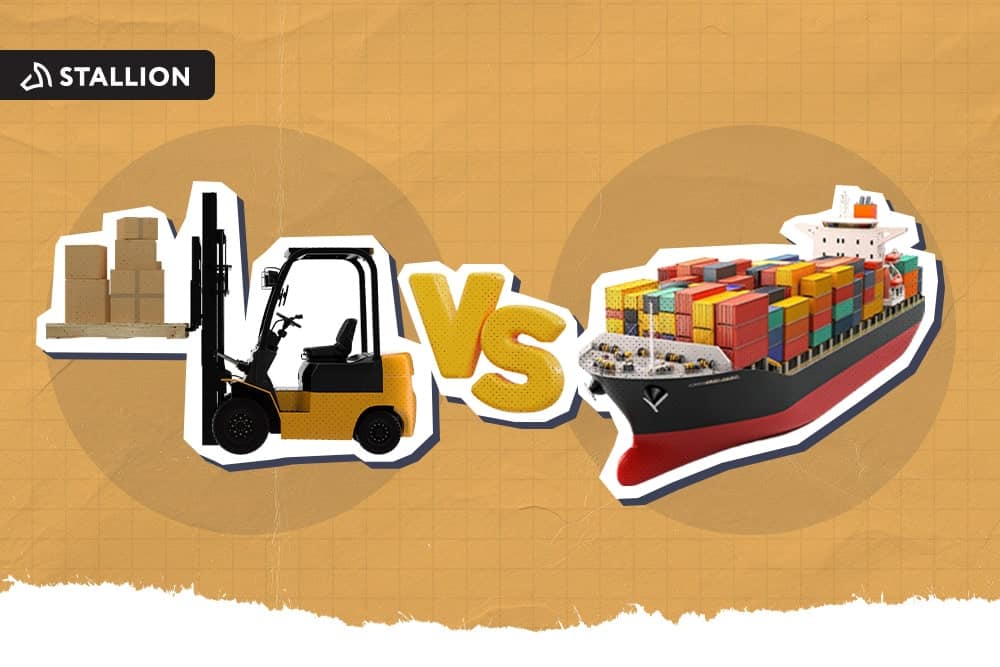
Over the last decade, the global container shipping industry has experienced remarkable transformations, enhanced by technological innovations, changes in trade patterns, and evolving consumer demands.
As the backbone of international trade, container shipping is crucial in connecting economies across continents and facilitating the movement of goods ranging from raw materials to finished products. This introduction overviews the significant statistical trends characterizing the global container shipping statistics over the past ten years, discussing the industry's growth, challenges, and prospects.

Understanding container shipping market statistics is crucial because it helps businesses and individuals track how goods move globally, impacting economies and everyday life. These statistics reveal trends in trade volumes, shipping costs, and port capacities, informing businesses about market demand and supply chain efficiency.
By knowing which goods are transported and where, companies can plan production and distribution effectively, ensuring products reach consumers on time. Additionally, policymakers use this data to formulate trade policies and infrastructure investments, fostering economic growth.
Ultimately, grasping container shipping market statistics enables smoother trade operations, enhances decision-making, and contributes to global economic development.

Various factors have shaped this dynamic sector, from expanding global trade to technological advancements and environmental concerns.
Let's explore the key developments in the container ship fleet industry over the last ten years, highlighting trends in fleet sizes, shipping routes, and industry challenges.
By examining these changes in simple terms, we gain insights into how the industry has evolved and what the future might hold for container shipping.
Over the past decade, the shipping world has seen some big changes. From bigger ships to smarter technology, how we move goods across oceans has evolved significantly.
This introduction sets the stage for exploring what's happening in the container shipping industry in the next 10 years. We'll look at trends, challenges, and innovations shaping how we ship goods around the world.

According to the latest data, the number of shipping containers worldwide is around 65 million. Shipping companies use these containers to transport various goods across oceans and continents like Asian and European Ports, helping in international trade.
The number of shipping containers will likely keep growing in the coming years because more and more stuff is being traded worldwide. But it won't happen fast; it'll gradually increase. Experts think that each year, the container number might increase by around 2 to 5%.
So, in a few years, we could see the additional number of containers reaching somewhere between 20 to 25 million. This growth reflects the ongoing expansion of global trade, with more goods being shipped between countries, including China, Norway, and countries in Latin America, driving the need for more containers to carry them.
Source: How Many Shipping Containers Are There in the World: An Overview of Global Container Statistics
Based on how heavy the freight is, about 16% of all the stuff we ship worldwide travels on a container ship fleet. This means that of everything we send from one country to another, like clothes, electronics, and food, around 16% of it is carried by these big ships transporting those metal containers.
So, while container ships are important for moving goods across oceans, they don't carry everything—just about 16% of the total weight of stuff shipped internationally.
On the other hand, when we look at how much money all the things we ship worldwide are worth, container ships are responsible for moving over 60% of that value. This means that many valuable things we trade internationally, like expensive electronics or designer clothes, are transported using container ships.
So, even though container ships might not carry most of the weight of all the stuff being shipped, they handle the most valuable goods, showing how important they are for global trade in valuable items.
Source: Global container freight rate index from the 12th January 2023 to the 4th January 2024

The shipping industry is poised for significant changes in the coming years, driven by factors like technology advancements, sustainability concerns, and evolving trade patterns. Here are some key trends businesses and customers can expect:
2. Focus on Sustainability
3. Resiliency and Adaptability
4. Evolving Trade Landscape
It's important to note that these are just some of the expected trends, and the shipping industry's future is complex and constantly evolving. However, understanding these trends can help businesses and customers make informed decisions and prepare for future changes.
As economies evolve and global trade patterns shift, it's crucial to understand the anticipated changes that will influence businesses and consumers worldwide. From technology to transportation, examine how factors like emerging markets, technological innovations, and changing consumer preferences will drive growth and shape market dynamics.

In the future, market expansion and diversification in the shipping industry refer to the idea that shipping companies will seek new opportunities and broaden their services to grow their businesses.
This could involve expanding into new geographic regions with increasing demand for shipping services. Additionally, companies may diversify their offerings by providing specialized services or targeting niche markets, such as refrigerated goods or oversized cargo.
For example, as global trade continues to evolve, emerging markets in regions like Africa and Southeast Asia present untapped potential for shipping companies to expand their operations. Moreover, advancements in technology and logistics may enable shipping firms to offer more customized and value-added services to meet the diverse needs of customers.
Market expansion and diversification are strategies to capitalize on new growth opportunities, reduce reliance on specific markets or services, and stay competitive in a rapidly evolving industry landscape. By embracing these approaches, shipping companies can adapt to changing market dynamics and position themselves for long-term success.

Yes, containerization is certainly increasing in international shipping. Here's a breakdown of the trend:
2. Quantitative Measures
3. Emerging Trends
Containerization shows no signs of slowing down. Its rising market share, value dominance, and adaptability point toward continued growth and diversification in the future of international shipping.

The impact of economic and geopolitical factors on global container shipping at present is multifaceted and complex. Here's a breakdown of the key influences:
2. Economic Factors
In 2023, a projected global economic growth slowdown may reduce international trade demand, potentially decreasing container shipping volumes. Additionally, rising inflation is causing uncertainty for businesses and consumers, impacting shipping costs and consumer spending.
Ongoing disruptions from the pandemic, trade conflicts, and regional tensions continue to pose logistical challenges and price volatility in the shipping industry. Fuel price fluctuations also significantly affect shipping companies' operating costs, influencing freight rates and business supply chain costs.
2. Geopolitical Factors
The ongoing Russia-Ukraine war has disrupted global trade routes, increasing fuel prices and creating uncertainty in the Black Sea region, impacting shipping activities. Concurrently, trade tensions between the US and China may result in tariffs, import restrictions, and trade diversion, affecting trade volumes and altering container shipping patterns.
Also, political instability and conflicts in regions like the Middle East and Africa can disrupt shipping routes and elevate security risks, consequently impacting shipping costs and insurance. Additionally, shifts in government regulations, such as stricter environmental standards or trade policies, may necessitate adjustments from shipping companies, influencing both costs and operations in the industry.
3. Combined Impact
The interplay of economic and geopolitical factors can result in increased shipping costs, heightened volatility in freight rates, and uncertainty for businesses engaged in global trade. Geopolitical tensions and trade disputes can potentially cause significant shifts in trade patterns, affecting specific routes and regions within the container shipping industry.
Consequently, companies prioritize resilience in their supply chains by diversifying sourcing and transportation options, aiming to mitigate risks associated with economic and geopolitical disruptions.

As the backbone of international trade, container ships are crucial in transporting goods across oceans, connecting producers with consumers worldwide. From the humble beginnings of containerization to the emergence of mega-container ships, we will uncover the intricacies of size classifications, cargo capacities, and the impact of these vessels on the efficiency and economics of maritime transportation.
Back then, ships are much smaller. They could only carry a limited amount of cargo, like barrels of goods or a few crates. But as trade between countries grew and people wanted to ship more things, ships needed to get bigger. So, over time, shipbuilders figured out how to make vessels larger and stronger.
As technology improved, ships began to evolve. Engineers developed smarter designs and better materials, allowing ships to carry more cargo while still floating safely on the water. This meant that instead of just a few crates, ships could now carry hundreds or even thousands of containers, all stacked neatly on each other.
These larger ships, known as container ships, revolutionized the shipping industry. They could transport goods more efficiently and cost-effectively than ever before. As demand for shipping continued to grow, ships kept getting bigger and bigger. Today, we have massive vessels called ULCVs that can carry incredible cargo, making them like floating cities on the ocean.

Projections and future trends in container ship sizes and capacities indicate a continued emphasis on building larger vessels to meet the growing demands of global trade. Some key projections and trends include:
Overall, the future of container ship sizes and capacities is characterized by a continued focus on efficiency, sustainability, and the evolving needs of international trade. As demand for goods continues to grow, container shipping will play a vital role in facilitating global commerce, with larger and more advanced vessels leading towards a more connected and efficient maritime transportation network.
The shipping industry has encountered several challenges and opportunities as it deals with changing economic, environmental, and technological landscapes. Let's examine the key challenges faced by the shipping industry in recent years, including geopolitical tensions, regulatory changes, and supply chain disruptions. Additionally, we will explore the opportunities emerging from technological advancements, shifts in consumer behaviour, and the growing focus on sustainability.

Supply chain resilience refers to a supply chain's ability to bounce back after facing problems. These problems can differ, like natural disasters like floods and earthquakes or artificial issues like trade conflicts.
They can also include economic troubles, pandemics like COVID-19, cybersecurity attacks, or even problems within the company like equipment breaking down. These issues can create big headaches for businesses, like running out of things to sell, spending more money on transportation, or customers getting angry because deliveries are late.
To tackle these challenges, businesses need to make their supply chains tougher. They can do this by having backup plans and not relying too much on one supplier or shipping route. They should monitor their stock and shipments in real-time and work closely with their partners to share information and solve problems together. Being able to change plans quickly and embracing new technologies are also important. Plus, it's essential to consider the environment by sourcing materials sustainably and reducing waste.
Building a strong supply chain isn't something a business does once and forgets about. It's an ongoing process. By being smart, monitoring risks, and using the right tools, businesses can keep their supply chains strong and successful, even when things get tough in the global market.

Technological disruptions are big changes that completely change how we live and work. They can affect different parts of our lives, like how digital cameras changed photography or how smartphones changed how we talk to each other and get information.
These changes can be good or bad. On one hand, they can make things more efficient, improve products and services, and help the economy grow. But they can also lead to job losses, make things uncertain, and create new problems like privacy concerns or inequality.
To deal with these changes, people and organizations need to be ready to learn new things all the time, be flexible, and invest in new ideas. Collaboration between different groups is also important, and everyone needs to consider the ethical issues of new technologies.
For example, schools need to teach kids about technology, businesses need to use automation and data better, and governments need to make rules that make sure everyone has fair access to technology.
But adapting isn't easy. It can cost a lot of money, and some people and organizations dislike changing. Plus, not everyone has the same access to technology, making things even harder. Overall, dealing with technological changes means being ready to learn, flexible, and working together to ensure everyone can benefit from new technologies.
Opportunities for making things better and more efficient are all around us in different areas and industries. Let's look at a few categories and examples:
But remember, these are just a few examples, and what works for one industry might not work for another. It's important to talk to others, look at what's already being done, and be willing to try new things to find the best solutions. We can make our world a better place by being open to new ideas and always looking for better ways of doing things.
We expect many factors to heavily influence industry evolution. These elements include technological integration, sustainability initiatives, and digital transformation. Meanwhile, automation, artificial intelligence, and data analytics will drive efficiency.
As for businesses, we can see that they will focus on eco-friendly practices and digitalization. Globalization will deepen, fostering increased connectivity and competition. Changing consumer preferences will prompt personalized products and sustainable solutions.
Regulatory changes will shape industries and focus on data privacy and environmental protection. Additionally, emerging sectors will disrupt traditional markets. With the help of new technologies, they can create new opportunities for innovation and growth. Businesses embracing these changes will grow in the dynamic industry landscape.
As we look at the statistics over the past 10 years, we can see major changes and challenges in the industry. We witnessed many events, from the 2008 financial crisis to the COVID-19 pandemic. Regardless, container shipping has had to adapt and innovate to survive.
Despite all these, the industry continues to grow and evolve. Using the newest technologies, businesses provide sustainability, driving change. As we move forward, it will be interesting to see how container shipping continues to develop and meet the world's demand.
Aman looks after the content marketing department at Stallion Express. He is passionate about helping businesses grow by providing informative and up-to-date trends in the eCommerce industry. Outside the office, you can find him on the soccer field cheering on Real Madrid.



Can our fellow Torontonians relate?
-
#smallbusiness #business #entrepreneur #socialmedia #shipping #ecommerce #canadianecommerce #shopify #poshmark #b2b #saas #etsy #ebay #canada #canadiansmallbusiness #shoplocalcanada #entrepreneur
#toronto

Here’s your quick hassle free shipping from 🇨🇦 to 🇺🇸 as a business owner!
-
Any questions?! Leave them 👇🏻 and save this video so you don’t forget!
-
#smallbusiness #business #entrepreneur #socialmedia #shipping #ecommerce #canadianecommerce #shopify #poshmark #b2b #saas #etsy #ebay #canada #canadiansmallbusiness #shoplocalcanada #entrepreneur

Meet @drinkbenny a 🇨🇦 female founded energy drink brand! Instead of focusing on their products, they’re taking a unique approach by hosting in person events in different Canadian cities to offer an experience for their community 🧡
-
What are your thoughts on in person events? 💭
-
#smallbusiness #business #entrepreneur #socialmedia #shipping #ecommerce #canadianecommerce #shopify #poshmark #b2b #saas #etsy #ebay #canada #canadiansmallbusiness #shoplocalcanada #entrepreneur

Do you know the difference between DDU and DDP when shipping internationally 🌏 ?
-
Questions? Leave them below! 👇🏻
-
#smallbusiness #business #entrepreneur #socialmedia #shipping #ecommerce #canadianecommerce #shopify #poshmark #b2b #saas #etsy #ebay #canada #canadiansmallbusiness #shoplocalcanada #entrepreneur

Here’s a quick hack to save time from choosing multiple postage options
↪️ Turn on the lowest postage rate automation to save you time!
-
Questions? Leave them below! 👇🏻
-
#smallbusiness #business #entrepreneur #socialmedia #shipping #ecommerce #canadianecommerce #shopify #poshmark #b2b #saas #etsy #ebay #canada #canadiansmallbusiness #shoplocalcanada #entrepreneur
